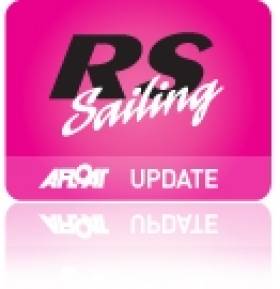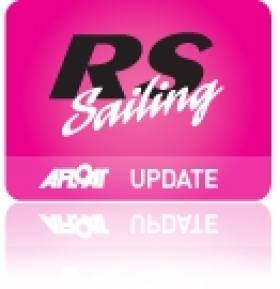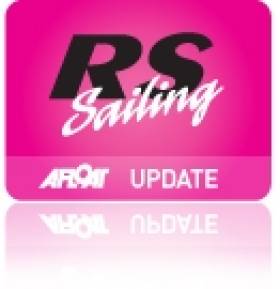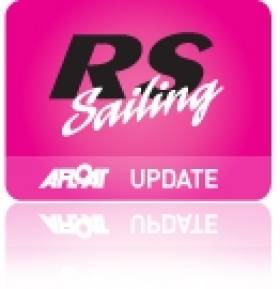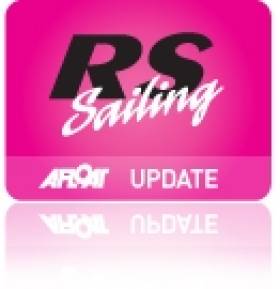Displaying items by tag: RS400
#rs – Some statistics from the Irish RS Sprint Championships 2014 at Ballyholme YC last weekend. 46 individual competitors (including Neill Strain's swaps), 40 Flight Starts, 214 recorded finishes, 490 individual hoists and drops (taking out DNFs etc), and a lot of weary bodies, not just the competitors! Full Sprint results are available to download below as a pdf file.
The Irish RS400 fleet has a full calendar for the year, along with the RS200s and Fevas, but with the exam season in full progress, there is usually a gap in May. The Sprints have thus been moved to fill this gap, and the excellent turn out justified the ongoing inclusion of this event in the calendar.
23 RS400s and an RS200 rolled out for the Annual Irish RS Sprint Championships, held for the first time in the North, with hosts Ballyholme Yacht Club under the guidance of our favourite Race Officer Robin Gray, putting on a tremendous event, in what always seems to me to be a complete nightmare of an event to run. Robin clearly loves a challenge, as he has offered to do it again next year!
Always a great opportunity to get some boat handling practice in, it also provides a workout for those of us navigationally challenged, and more than a few salvages were provided on my boat by Steve advising me where to point the boat next. The whacky M course was a great success, sort of slaloming to the left, and then having an on the edge kite reach across the bottom, to make sure you didn't recover too much before the next race.
We have always asked that we are not kept sitting around too long, and Robin's team kept things pinging off at a furious rate, not giving you time to realise how your body was slowly disintegrating as the afternoon progressed. That said, I was pleased to see that some of the young ones were whinging as much as we elder statesmen, about how battered they felt.
In a Northerly there are few better venues than Ballyholme, with champagne conditions (can we finally park that expression, though it does serve the purpose I guess) of 15 knots steady, a 3-4 foot short swell allowing some fruity downhill slides. As good as it gets I'd say. Also clearly suits the locals, with Bob Espey and Gareth Flanagan and their respective engineers, Mike Gunning and Dave Fletcher, leading the way, along with Sean Cleary and Steve Tyner from Greystones, current Inlands Champs, in amongst the leaders. The flights were rejigged midway through Saturday, and again for Sunday, giving no-one any idea who was winning, apart from the obvious fact the Bob and Mike were running away with it. That said, everyone had a piece of the action, and as always, when the racing is good, we all go home happy.
Biggest thanks however have to go to the mark layers, who did an unbelievable job to lay and move so many marks with so little delay, outstanding.
Next up is the slightly less chaotic RS Northerns at Strangford Lough Yacht Club in late June, with usual format windyleewards; though if the size and intensity of the Easterns was anything to go by, carnage and chaos will return. We should have some serious entertainment, as the deep southerners, from the fast growing and worryingly talent packed Cork fleet, fresh from their own Sprint event, rejoin the fray. Great times for the RS fleet.
#rssailing – With single day entry for busy people, Ballyholme Yacht Club on Belfast lough is pulling out all the stops to make a big success of this month's Irish RS400 and RS 200 Sprint Championships. Staged on Saturday 24th and Sunday 25th May 2014 there will be 16 races over two days with new "M type" or "box type" courses. The Notice of Race is posted below for download as a pdf file.
'RS400 Explosion of Action and Enthusiasm', A 'Newbie' Comments
#rssailing – David Rose, a new member of the RS class, sends these comments on the weekend's Eastern Championships at Greystones.
As one of the new members of the RS400 class in Ireland, and someone who has not sailed a dingy for a while, I arrived at Greystones for the Irish RS-Eastern Championships not fully knowing what to expect. What I found was a very welcoming club and town, with great facilities for dinghies. More Importantly I found a class that was from all four provinces of Ireland and for the purest sailor at any given level.
The RS400 fleet has simply exploded. Going from a good base over the last few years, the spike in interest and enthusiasm has been enormous and one suspects this boom for the RS400 will also lead to bigger fleets in the smaller sister class of RS200 who share events and also have a great Irish fleet.
The numbers say it all, this was the first event of season, and an unbelievable turnout of 27 RS400's from all over Ireland and 14 200's fought it out in exciting conditions all weekend. The Feva class was also well attended and made for a great mix of people in the dinghy park.
As a newbie to the class, I could not have met with more people willing to share information or a helping hand, be it on boat setup or how to get the most out of my 400 on the water. A few people in the class have tirelessly promoted the boats over the last few years, by not just facilitating the movement of boats from the UK mainland to Ireland, but also by encouraging people to get involved in what is now the largest single fleet on these shores, and probably the most competitive.
These boats are not brand new, this year they will celebrate their 20th national championships in the UK. This means that there is a low barrier to entry for the class with boats ranging in value from £1,500 for an entry level model, up to £10k for those of us no longer thinking about the recession. A good one can be bought for £3,500, or an older one can be brought up to race speed quite easily with a few upgrades to the equipment. The hulls have stood the test of time very well, with low numbers featuring in the results both in the UK and Ireland at every event.
This class is an exciting, affordable option for the Irish sailor, and offers up a great circuit on this Island and abroad in the UK or if you are very adventurous, there is a regular event in Lake Garda, where one can combine a sun holiday with some top class racing.
I am sure the Irish class association will release a full race report on the ups and downs of the racing which was sailed in very difficult conditions and won in the end by local sailor Sean Cleary and his crew Steve Tyner by the slimmest of margins from Alex Barry and George Kenefick from Cork and establish runners Bob Espey and Michael Gunning from Ballyhome Yacht Club.
Royal Cork's Dinghy PY 500 Regatta Success in Cork Harbour
#rcyc – Weather obliged beautifully for PY 500 making a perfect Sunday morning event at Royal Cork Yacht Club writes Claire Bateman. And what a magnificent spectacle the PY500 (Portsmouth Yardstick) race turned out to be. The sun was shining and there was a Westerly breeze of some 15 knots lightening slowly during the race. The course was Windward/Leeward around laid marks and consisting of seven rounds.
The event consisted of a mixed dinghy race for vessels holding a PY Handicap of 700-1320. Results are downloadable below as a jpeg file.
Due to the thirty one boats participating and the different speeds involved there were officials in position at each mark to record each competitor rounding for each of the seven rounds. Due to the location of the course up and down the river outside the club magnificent spectator viewing was provided for the large numbers present.
There were many boats from different classes represented and they certainly provided spectacular viewing.
The representatives were from National 18s, 505's, RS 400, RS 200, a lone Finn, Fevas, Fireflies, Lasers of all rig types, a Rankin and the star of the show, a 29er that charged around the course showing such style with a fluorescent orange Gennaker. Spotted sailing his RS 200 with his wife Heather was Sean Craig from the RstGYC. Also sailing from the RCYC's own club boats were 2 Topaz, one Magno and one Omega.
In between all this flying action there were Optimsts, 420s and 1720s all setting out for training and all in all there was a tremendous buzz in the club.
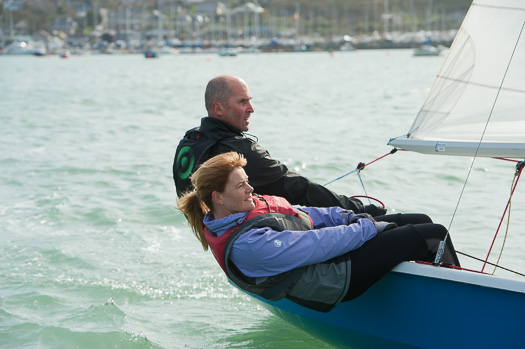
Sean and Heather Craig travelled from Dun Laoghaire for Royal Cork's PY 500. More photos by Bob Bateman below.
It must have made interesting and delightful viewing in the lovely conditions for the members and friends arriving for Sunday lunch at the Club's Globe Restaurant.
All credit due to the organisers and so obviously successful and enjoyable they might consider a repeat performance.
Irish RS 2014 Event Calendar Announced
#RSsailing – The RS Association has announced its event calendar for 2014. These events include all three RS classes, the Feva, 200 and 400 unless otherwise specified.
Primary RS circuit events:
April 12/13th Greystones S.C. Eastern Championships.
June 21/22nd Strangford Lough S.C. Northern Championships.
July 19/20th Lough Ree Y.C. Western Championships.
August 8-10th Galway Bay S.C. Crewsaver Irish National Championships.
September 13/14th Kinsale Y.C. Southern Championships.
Sprint events:
May 24/25th Ballyholme Y.C. RS200/400 Sprint event.
June 7th Monkstown Bay RSFeva/200/400 Southern Sprint event.
UK/European events:
July 25 – August 1st Carnac, France Feva Worlds
July 27th – August 1st Fraglia vela Riva, Lake Garda, Italy RS 200/400 Eurocup
August 17th – 21st Hayling Island, UK RS200 UK Nationals
August 24 – 28th Mounts Bay, Cornwall UK RS400 UK Nationals.
RS Class Postpone Dun Laoghaire Dinghy Demo Day Due to Weather
#rssailing – A bad weather forecast means the planned RS demo day in Dun Laoghaire this Saturday has been postponed. The up and coming dinghy class is completely bucking the trend oulined in a recent piece that outlines some major problems for dinghy sailing in Ireland, acoording to class proponents.
This year 44 RS400's attended the nationals and 33 boats took part in the five event traveller series. In the past month five RS400's have been bought from the UK to join the Irish fleet. This includes the first two 400's based in Cork and one in Dun Laoghaire.
The formula of running the RS Feva, RS200 and RS400 events together has proved hugely successful. At the combined nationals they had 72 boats in total. The classes give juniors and those above college age who may not have the aspirations or perhaps the means for Olympic sailing, a natural progressive platform for competitive racing. There are a lot people sailing in the RS classes that could have drifted away from sailing altogether.
Being a strict one design and non-trapeze the boats are very accessible. Swapping and introducing new crews is not as much of an issue, particularly for those who haven't been in a dinghy for years or in some cases ever.
Another point that is worth making is the competitive level in the classes. For example, Ryan Seaton and Matt McGovern (49er Olympians) own and race a 400 when their 49er schedule allows. Gareth Flannigan is now an RS400 regular. Dave Rose from Cork and formerly of 1720 fame has just bought a 400. This will be Dave's first time back in a dinghy in fifteen years. At the competitive end of the RS200's, Sean & Heather Craig have just bought a boat from the UK. Their son has commandeered the current family 200.
The boats are deemded good value due to the large UK second hand market. An RS400 cost €4,000 and has no problems competing at the right end of the fleet.
RS Sailors at Blessington for Inland Champs
#RSsailing – Blessington Sailing Club is hosting the 2013 RS Inland championships and after three races Franks and Kevin O'Rourke lead the biggest fleet, the 12–boat RS200s. Blessington's own Alison Dolan and Grainne Young top a 6–boat Feva fleet. Another Greystones boat, sailed by Simon Herriott and Tom Moran, lead the 11–boat RS400 fleet. Results to date are downloadable below as a html file.
No Sunshine But Cork Harbour Delivers the Goods for RS Fleets
#RSSailing – A fleet of 10 RS400s gathered for the Southerns, with several significant teams missing such as last year's National Champions Emmet and James Ryan from RStGYC, Ryan Seaton and Matty McGovern, back on the Olympic 49er campaign, Mike Ferguson and Jeremy Tomalin from Ballyholme and Team Artemis, and the majority of the RNIYC fleet save for DrC and Stevie Kane. This gave a few teams the chance to focus on toppling this season's top duo of Dr Bob SP and Mike G. Sadly for the rest, the current hotshots swiftly gave them a good seeing to, with a trio of runaway victories on Day 1, with only local Monkstown man and top 505 driver Alex Barry, teaming up with fellow Monkstowner Dave Doherty, to chase them down, as the rest struggled to come to terms with the ripping tides on the spring tide weekend. Indeed the new pairing demonstrated a potent turn of speed, after some sneaky two boat tuning with Royal Cork's Aidan MacSweeney. This just went to show that Dave's "old yellow boat" was anything but slow, cementing a strong second place overnight.
As the freshly beaten crews rushed off to Cronins for some of Ireland's finest Guinness and Seafood Chowder, a critical three way protest hearing was being played out, which would have a dramatic though ultimately irrelevant effect on the overall standings. Multiple Irish Champion Garrett Flannigan from Ballyholme, sailing with Dave Fletcher, was flicked as a result of some leeward mark chaos, though by the time he got to Cronins, no-one understood what the issue was, and a jovial night's craic ensued. Mature heads managed to limit the damage, leaving the event leaders to make a few poor decisions at the RCYC Bar late in proceedings, and come out for Sunday's racing having lost some of their polish.
With the tide now pointing in the opposite direction, and a large ship parked just upwind of the windward mark, opportunities were aplenty to throw it all away, and the Bangor duo set about doing just that. Whilst Simon Herriott and Tom Moran (aka Sprinkles) from Greystones chipped away with another couple of podiums, the big story was a turbocharged challenge from Flannigan, who was clearly giving it some Ben Ainslie, and promptly yotted past everyone downwind with a rude turn of speed, to take bullets in races 4 and 5, with some ease. Witnessing this performances, SP and Gunning decided to see who else was racing and sailed round at the back of the fleet, posting a "shocker" in race 5, to make it game on again.
So race 6 set off with DrC winning the pin for the first time in his illustrious 35 year campaign, and Garry Flannigan tacking into some oncoming traffic or similar. Sadly this mirrored precisely Race 5, only the wrong way round for Gary, as the win he needed to match with SP having a 5 or worse, was in fact reversed, and SP took the gun and the whole shebang, whilst Flannigan disappeared out the back, having to settle for runner up. The 400 is an unforgiving mistress!
Great fun altogether, and especially good to see Dave Doherty and Alex doing so well, only missing out to Dr C and Steve on countback for the bottom step of the podium. Hopefully these guys will form the nucleus of a new planned Cork based contingent and give us an excuse to come back here again in future, to one of Ireland's most beautiful venues.
Like the 400s, the 200s arrived in Cork on Friday evening quite an eclectic but incomplete bunch... we were missing our usual head of the fleet boats but knew there would be healthy competition with Stephen Craig and Conor Foley from the George who, although comparatively new to the fleet, made their mark at the Nationals coming in fifth overall, the Greystones pair Conor Cleary and Aaron Jones who have spent so much of their summer on the water and Lisa Smith and Kate Hayes who are soooo good downwind. After a summer of light wind events we were all really looking forward to some screaming reaches....
On Saturday we woke to very calm conditions. We waited for an hour after the briefing and it began to pick up a little.... So we headed out for the long reach North to find some depth in Cork harbour and race 1 began as the tide was on the turn.
First up wind leg was a jostle for places and there proved to be chopping and changing throughout the race. But race one belonged to the young guns with Royal St George's Stephen Craig and Conor Foley pulling ahead on the second downwind leg, maintaining their lead to the finish. They were followed by Greystones' Conor Clery/Aaron Jones in second with Sarah & Molly Byrne narrowly taking third from fellow Greystones sisters Rachel & Sarah Hoolahan
A calmer start for the second race, those choosing to go right made gains out of the tide. Mother daughter team, Sarah and Molly lead from the start with Conor and Aaron slipping back throughout the race and RStGYC daughter/father pairing Clodagh & Adrian Hinkson taking second with Gabrielle Igoe/Trish Clery in third and Stephen and Conor in fourth.
Race 3 began with all boats very close up the beat. Stephen Craig and Conor Foley took the lead early but found it difficult to shake off Lisa Smith/Kate Hayes and Conor Clery/Aaron Jones for two laps leaving quite a stretch between them and the following fleet. However on the third lap Sarah & Molly Byrne gradually picked off boats to round the windward in second in a very strong tide and slackening breeze. Lisa Smith's supremacy downwind ensured she snuck ahead before the final leeward mark rounding as both boats caught up with Stephen and Conor who had found a hole. All three rounded the mark in quick succession with Sarah/Molly forced to tack off into the tide immediately. However, they just managed to cross the two boats before the finish but Stephen got ahead and Sarah/Molly only just managed to tack and pip Lisa/Kate to the line in a sudden unexpected gust sneaking in around the Committee Boat as the Hoolahans watched the close finish from fourth place. Overall there was very close racing up and down the fleet, leaving Royal St George pairing Stephen Craig/Conor Foley and Greystones Sarah & Molly Byrne on equal points overnight but the George boat with two firsts. A protest from race three later forced Lisa Smith/Kate Hayes to lose their best result of the day before the party started.
Sunday dawned to a very calm Cork Harbour and a long sail out to Cuskinny. Greystones boats, Sarah/Molly and Lisa/Kate chose the pin end to start, going left and led up the first beat. Very close downwind racing and some admirable sportsmanship from Lisa, allowed the Byrnes to sneak ahead and take the first, Lisa and Kate second with the young guns from the George taking a third.
With the discard, the Craig/Foley George duo and Greystones Byrnes were still on equal points. The next two races were confidently led by the Hinksons who had really got in to their stride with Stephen Craig and Conor Foley successfully covering the Byrnes to maintain their lead and in the process managing to take another two bullets and first overall, the Byrnes second and the Hinksons third. The finish of race six had the first five boats round the last mark in quick succession and finish within a minute...... a testament to the close racing over the weekend across a diverse mix of crews in terms of gender, age (16-50) and weight (couldn't possibly comment)– a very 200 finish!
In the RS Feva class, the Royal Cork's Luke McGrath and Eoghan O'Regan won the first race in what was their first outing in the boat but were soon ousted by RCYC Jill McGinley and Maeve O'Sullivan who in spite of a split jib, won the 2nd race. Monkstown's Luke Fehilly and Shane Dunlea took the last race of the day with Monkstown Bay's Martha Fehily and Jenny O'Leary also performing well on Saturday with two seconds in the bag.
On Sunday, Jill and Maeve, armed with a new jib, dominated day two for the Fevas to win the event with another 3 bullets. Luke and Eoghan remained consistent to claim 2nd place overall and Monkstown's David Hyland and Charlie Moloney came in third.
We didn't get the sunshine nor the signature RS screaming reaches the forecasts had promised, but the superb race management more than made up for it with three fleets on the same course and all races sailed. Huge thanks to PRO Peter Crowley and his efficient team, Rear Admiral Darren O'Keeffe, Feva Class captains Rory Fitzpatrick and Ed Rice and the extended team at RCYC for a really good event, camping facilities, yummy food and a great welcome.
We look forward to the last event of 2013 for the Irish RS Classes, the RS Feva RS200 and RS400 Inlands hosted by Blessington Sailing Club on the 12th and 13th of October. Early entry discount closes Friday 4th October.
RS200, RS400 & Feva Fleets Northern Champs at Ballyholme
RS – After five races sailed Robert Espey and Mike Gunning won the RS400 Northern championships hosted by Ballyholme Yacht Club this weekend.
Despite the absence of wind forecast, and despite Charlie Horder not showing up, the weekend turned out to be a roaring success, with ever reliable Robin Gray as PRO slotting the perfect duration races into the various wind slots that existed, giving the three fleets great racing.
It was exciting to see some new faces in the RS Fevas, since McCready Sailboats took over dealership, and have been promoting and lending out boats. All 6 of the boats, in the fleet that normally travels from Dublin or Greystones, were from the North. This must augur well for the future, with several parents present realising they could have actually have been sailing in the 400s instead of acting as shore crew.
In the RS200s, Clive Coffey from Newcastle, was dominant in the generally f2-3 conditions, taking first overall from Greystones regulars Frank O'Rourke in second, and Sarah Byrne in fourth, with East Down's Trevor Fisher splitting them in third.
The main event though was in the RS400s, where a super strong line up including current Irish Olympic 49er sailors, and winners of this year's Weymouth Sail for Gold World Cup Series' Championship, Ryan Seaton and Matty McGovern headlined a strong line up of past National and European Championship winners from a multitude of classes. Racing was tight, with the front 6 or 7 generally working through, but with anyone capable of making a podium slot. Overnight it looked to be all about Bob Espey vs Emmet Ryan, but Sunday saw things get a lot tighter, with Gareth Flannigan and Dave Cheyne staying consistent, and nearly turning things around in race two, when Flannigan's lead was slashed on the final run of race two, in what would prove a decisive moment, allowing the Olympic duo a little breathing space as the 3rd,4th and 5th boats rolled the leading pair on the final approach, Espey grabbing an essential win. Race 4 saw Emmet and brother James struggle and take a discard, so it was advantage Espey/ Gunning again.
Race 5 was held in sparkling Ballyholme sea breeze and sunshine, with Dave Cheyne and Stevie Kane from RNIYC breaking clear of the pack, chasing the Ryan brothers. As the two teams extended, it looked like the goose was cooked for Espey, but a last attack on the right corner gybe allowed the fat old boys from Royal North to roll Ryan, and take the win. This instantly threw the result back to Espey and Gunning, who were suddenly back level on points, but with a pair of bullets, to the Ryans only one now, the title went to Espey in dramatic fashion, and past Irish Champions Emmet and James left to lick their wounds. Awesome racing as ever, with some new faces feeling the heat, as those new in last season starting to move up the leader board after a year of hard racing under their belts.
Lots of new boats arriving by the week, with several more expected in Ballyholme in time for the Autumn Grange Wine Merchants Series at Bangor on Sundays from the 8th September, before the fleets head to Crosshaven on September 21/22nd. The hope is the 4 or 5 potential new 400 owners in Monkstown SC in Cobh will have boat boats in time, to compliment the new arrival of Aidan Macsweeney, and also Dave Doherty who currently have boats in the area.
Full results for all divisions are downloadable below as an attached html file.
Two races were sailed today in predominantly light conditions at the combined RS Championships at Ballyholme Yacht Club. The race officer made a good call to postpone proceedings until Sunday when the afternoon breeze completely shut down.
There are 18 RS 400's, 8 RS200's and 6 RS Fevas competing.
RS400 Results:
1st E.Ryan J.Ryan R1(2) R2(1)
2nd J.Espey M.Gunning R1(1) R2(3)
3rd D.Cheyne S.Kane R1(3) R2(5)
4th M.Ferguson J.Tomalin R1(7)R2(2)
5th R.Seaton M.McGovern R1(5)R2(4)
6th G.Flannigan D.Fletcher R1(4)R2(7)
RS200 Results:
1st C.Coffey H.Cassidy R1(2) R2(1)
2nd F & K O'Rourke R1(1) R2(5)
3rd R.Milligan P.Blamphin R1(5) R2(2)
RS Feva Results:
1st N.Eames M.Fekkes R1(3) R2(1)
2nd B.Coburn A.Mitchell R1(1) R2(5)
3rd R.Fekkes A.Harley R1(1) R2(6)



























